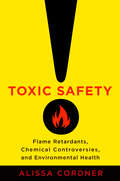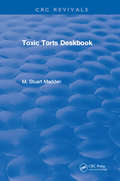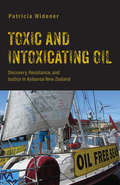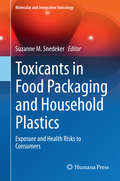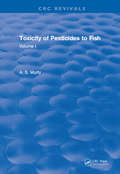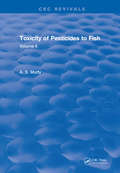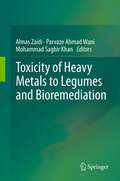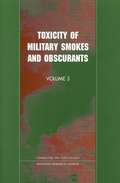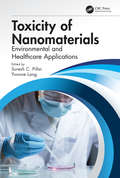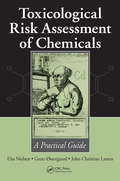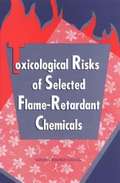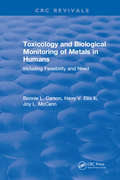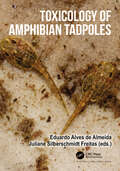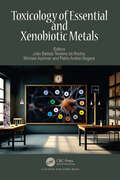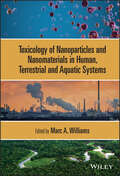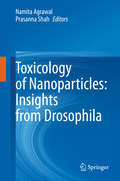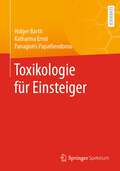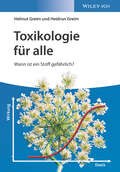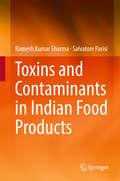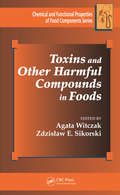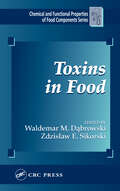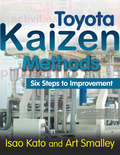- Table View
- List View
Toxic Safety: Flame Retardants, Chemical Controversies, and Environmental Health
by Alissa CordnerInitially marketed as a life-saving advancement, flame retardants are now mired in controversy. Some argue that data show the chemicals are unsafe while others continue to support their use. The tactics of each side have far-reaching consequences for how we interpret new scientific discoveries.An experienced environmental sociologist, Alissa Cordner conducts more than a hundred interviews with activists, scientists, regulators, and industry professionals to isolate the social, scientific, economic, and political forces influencing environmental health policy today. Introducing "strategic science translation," she describes how stakeholders use scientific evidence to support nonscientific goals and construct "conceptual risk formulas" to shape risk assessment and the interpretation of empirical evidence. A revelatory text for public-health advocates, Toxic Safety demonstrates that while all parties interested in health issues use science to support their claims, they do not compete on a level playing field and even good intentions can have deleterious effects.
Toxic Torts
by Carl F. CranorThe relationship between science, law and justice has become a pressing issue with US Supreme Court decisions beginning with Daubert v. Merrell-Dow Pharmaceutical. How courts review scientific testimony and its foundation before trial can substantially affect the possibility of justice for persons wrongfully injured by exposure to toxic substances. If courts do not review scientific testimony, they will deny one of the parties the possibility of justice. Even if courts review evidence well, the fact and perception of greater judicial scrutiny increases litigation costs and attorney screening of clients. Mistaken review of scientific evidence can decrease citizen access to the law, increase unfortunate incentives for firms not to test their products, lower deterrence for wrongful conduct and harmful products, and decrease the possibility of justice for citizens injured by toxic substances. This book introduces these issues, reveals the relationships that pose problems, and shows how justice can be denied.
Toxic Torts Deskbook
by M. Stuart MaddenToxic Torts Deskbook is a concise, readable text covering the fastest-growing area of tort and personal injury litigation.Toxic tort suits involve claims arising from exposure to products ranging from pesticides to industrial solvents, manufacturing waste, and asbestos and present unique questions regarding causation, degree of hazard, and expert testimony.Written for environmental professionals as well as attorneys, Toxic Torts Deskbook describes the principal causes of suits for negligence, nuisance, trespass, warranty, strict tort liability, and liability for abnormally dangerous activities. For environmental, product, and workplace injuries from toxic exposure, the book discusses the elements a claimant must plead and prove, as well as defenses, statutes of limitations for long latency harms, and limited immunity for government contractors. "Citizen suits" that individuals may bring to vindicate rights granted by state or federal environmental statutes and insurance coverage issues, including the metes and bounds of the "pollution exclusion", are also covered.
Toxic and Intoxicating Oil: Discovery, Resistance, and Justice in Aotearoa New Zealand (Nature, Society, and Culture)
by Patricia WidenerWhen oil and gas exploration was expanding across Aotearoa New Zealand, Patricia Widener was there interviewing affected residents and environmental and climate activists, and attending community meetings and anti-drilling rallies. Exploration was occurring on an unprecedented scale when oil disasters dwelled in recent memory, socioecological worries were high, campaigns for climate action were becoming global, and transitioning toward a low carbon society seemed possible. Yet unlike other communities who have experienced either an oil spill, or hydraulic fracturing, or offshore exploration, or climate fears, or disputes over unresolved Indigenous claims, New Zealanders were facing each one almost simultaneously. Collectively, these grievances created the foundation for an organized civil society to construct and then magnify a comprehensive critical oil narrative--in dialogue, practice, and aspiration. Community advocates and socioecological activists mobilized for their health and well-being, for their neighborhoods and beaches, for Planet Earth and Planet Ocean, and for terrestrial and aquatic species and ecosystems. They rallied against toxic, climate-altering pollution; the extraction of fossil fuels; a myriad of historic and contemporary inequities; and for local, just, and sustainable communities, ecologies, economies, and/or energy sources. In this allied ethnography, quotes are used extensively to convey the tenor of some of the country’s most passionate and committed people. By analyzing the intersections of a social movement and the political economy of oil, Widener reveals a nuanced story of oil resistance and promotion at a time when many anti-drilling activists believed themselves to be on the front lines of the industry’s inevitable decline.
Toxicants in Food Packaging and Household Plastics
by Suzanne M. SnedekerThis book serves as a comprehensive resource on toxicants that can be released from food packaging materials and household plastics. Chapters include sources and levels of chemical exposure, known and suspected health effects and the identification of data gaps with recommendations for further research. In addition, regulatory approaches and risk assessment challenges in the United States and Europe are discussed. Chapters cover both the more widely known chemicals that can migrate from food packaging (bisphenol A, perfluorinated chemicals), and household plastics (lead, phthalates, brominated flame retardants), as well as chemicals that are just entering use in food packaging (nanomaterials in polymer food packaging) and chemicals recently identified as migrating from food packaging to food stuffs (phthalates, benzophenones, antimony, methylnaphthalene and the alkylphenols nonylphenol and octylphenol). Chapters on phthalates and brominated flame retardants discuss challenges that arise with the use of replacement chemicals. The health effect sections of chapters have drawn on a wide variety of toxicological endpoints and recommend approaches to better assess toxicological risks in vulnerable human populations. Reflecting the global nature of our food supply and household consumer goods, contributions have been drawn from international experts. A wide range of scientists will find this book to be useful, including toxicologists, environmental health scientists, food scientists, and regulators.
Toxicity Of Pesticides To Fish: Volume I
by A.S. MurtyThe present work is the first major attempt at reviewing comprehensively all the available information about the environmental fate and behaviour of the xenobiotic chemicals.
Toxicity Of Pesticides To Fish: Volume II
by MurtyThe present work is the first major attempt at reviewing comprehensively all the available information about the environmental fate and behaviour of the xenobiotic chemicals.
Toxicity Of Pure Foods (Routledge Revivals)
by E. M. BoydFirst Published in 1973, this book offers a full, comprehensive guide into the toxicology of certain foods. Carefully compiled and filled with a vast repertoire of notes, diagrams, and references this book serves as a useful reference for students of toxicology, and other practitioners in their respective fields.
Toxicity of Heavy Metals to Legumes and Bioremediation
by Almas Zaidi Mohammad Saghir Khan Parvaze Ahmad WaniThis title discusses various effects of heavy metal exposure to legumes as well as the bioremediation potential of rhizosphere microbes. Availability of heavy metals, their uptake and the effects of metals on various signaling pathways within legumes are presented. Furthermore, the effects of heavy metals to nitrogen fixing microorganisms and how microsymbionts can overcome metal stress is presented in detail. The role of nitrogen fixers in decontamination of heavy metal toxicity, mycoremediation of metal contaminated soils, microbially mediated transformation of heavy metals and action of plant growth promoting rhizobacteria and nitrogen fixers together in detoxifying heavy metals are broadly explained. This volume is a useful tool for scientists, policy makers and progressive legume growers intending to develop safe and healthy legumes for future generations.
Toxicity of Military Smokes and Obscurants: Volume 3
by National Research CouncilThe National Academies Press (NAP)--publisher for the National Academies--publishes more than 200 books a year offering the most authoritative views, definitive information, and groundbreaking recommendations on a wide range of topics in science, engineering, and health. Our books are unique in that they are authored by the nation's leading experts in every scientific field.
Toxicity of Nanomaterials: Environmental and Healthcare Applications
by Suresh C. Pillai Yvonne LangThis comprehensive book, edited by two leading experts in nanotechnology and bioengineering with contributions from a global team of specialists, provides a detailed overview of the environmental and health impacts associated with the toxicology of nanomaterials. Special attention is given to nanomaterial toxicity during synthesis, production and application, and chapters throughout are focused on key areas that are important for future research and development of nanomaterials. This book will be of interest to advanced students studying biomedical engineering and materials science, PhD researchers, post-docs and academics working in the area of nanotechnology, medicine, manufacturing and regulatory bodies. Features: Collates and critically evaluates various aspects of the toxicology of nanomaterials in one comprehensive text Discusses the various effects of nanocrystals including the morphologies on cytotoxicity, in addition to the environmental and cytotoxicity risks of graphene and 2D nanomaterials Explores practical methods of detection and quantification, with applications in the environmental and healthcare fields
Toxicological Risk Assessment for Beginners
by José A. Torres Sol BobstThis book serves as a comprehensive introductory guide to the practical aspects of risk assessment. Chapters include clearly defined objectives and summaries. The book includes: hazard identification, dose-response, exposure assessment, risk characterization, chemical mixtures, epidemiology, emerging issues and global perspectives with accessible language. The book concludes with a set of hypothetical case studies. Toxicological Risk Assessment for Beginners aims not to create an expert, but rather to provide readers with their first understanding of the risk assessment topic. This book was designed with the student in mind. We simplify a complex process for beginners and balance theory with practical aspects, but remain fluid enough to increase difficulty with case studies. By incorporating an action based, step by step approach to learning the risk assessment process, this book provides its readers with an elementary understanding of how the risk assessment process is initiated, developed and finished, making it a valuable guide for graduate students, post-doctoral fellows and early career scientists in industry.
Toxicological Risk Assessment of Chemicals: A Practical Guide
by Elsa Nielsen Grete Ostergaard John Christian LarsenUnlike many existing books on toxicology that cover either toxicity of a particular substance or toxicity of chemicals on particular organ systems, Toxicological Risk Assessment of Chemicals: A Practical Guide lays out the principle activities of conducting a toxicological risk assessment, including international approaches and methods for the risk
Toxicological Risks of Selected Flame-Retardant Chemicals
by National Research CouncilIn its fiscal 1999 appropriations report, Congress directed the US Consumer Product Safety Commission to arrange for an independent study by the National Research Council to conduct toxicological assessments for flame-retardant (FR) chemicals that are likely to be used on furniture upholstery. This report evaluates the toxicological, epidemiological, and exposure data on 16 specified FR chemicals and characterizes risks to human health from exposure to furniture upholstery treated with such chemicals. Introductory chapters discuss the study purposes, assessment process, and methodology. An appendix presents information on the durability and permanence of flame-retardancy in fabrics. The volume is not indexed. Annotation c. Book News, Inc. , Portland, OR (booknews. com)
Toxicology Biological Monitoring of Metals in Humans
by Bonnie L. CarsonAs one of many tasks of an analytical chemistry program sponsored by the office of Pesticides and Toxic Substances, Field Studies Branch, U.S. Environmental Protection Agency (EPA) (EPA Prime Contract No. 68-02-3938), Midwest Research Institute (MRI) prepared these summaries of the mammalian toxicology of 52 individual elements (metals and metalloids) and the lanthanides (rare earth elements). MRI is assisting the EPA in developing protocols for the monitoring of selected metals and organic compounds in the blood of the general U.S. population. The monitoring will enable evaluation of changes in the blood levels over time and any trends associated with instituted control measures. This review will help EPA select the metals to be included in the monitoring effort based on toxicity, relative exposure, and the ability of blood measurements to reflect exposure.
Toxicology of Amphibian Tadpoles
by Juliane Silberschmidt Freitas Eduardo Alves de AlmeidaAnuran amphibians are among the animal groups with the highest rate of population decline on the planet. Among the factors driving this decline are environmental pollutants, whose negative effects on larvae and tadpoles are still relatively little studied. This is the first book devoted entirely to studying the effects of environmental pollutants on amphibian tadpoles. Throughout its 14 chapters, various aspects of the toxic effects of different classes of environmental contaminants are explored, such as the toxicokinetics of toxic compounds in tadpoles and their health effects, which may result in negative consequences at populations level.
Toxicology of Essential and Xenobiotic Metals
by Michael Aschner João Batista Teixeira da Rocha Pablo Andrei NogaraThis book explores how metals like cadmium, mercury, lead, aluminium, manganese, and chromium can harm our health, whether through short-term or long-term exposure. It covers symptoms ranging from immediate nausea to long-term issues like Parkinson's and Alzheimer's diseases. Understanding how these metals interact with our bodies is crucial for identifying their harmful effects. The book, divided into 11 chapters, provides straightforward explanations about how these metals affect our health, making it useful for anyone interested in understanding how metals can impact the environment as well as human and animal health.
Toxicology of Nanoparticles and Nanomaterials in Human, Terrestrial and Aquatic Systems
by Marc A. WilliamsToxicology of Nanoparticles and Nanomaterials in Human, Terrestrial and Aquatic Systems An indispensable compendium detailing the toxicology of nanoparticles with a focus on mechanisms, emerging issues, and new approaches Toxicology of Nanoparticles and Nanomaterials in Human, Terrestrial and Aquatic Systems provides authoritative information on the toxicology of ultrafine and nanoparticulate matter that contaminate terrestrial or aquatic environments and present unique challenges in applied public health and toxicological research. Detailed chapters by a panel of world-renowned experts examine the complementary and dynamic interdependence of aquatic, terrestrial, and human systems and the toxicological impacts on exposure to engineered and manufactured nanoparticles and nanomaterials. Organized into four sections, the book opens with a thorough overview of the field, including known challenges and the necessity for current research activity. The second section describes terrestrial and aquatic systems and the ecotoxicological impact of nanomaterials, followed by critical analysis of the many human health effects of nanomaterials. The book concludes with an in-depth discussion of current gaps in knowledge, future directions, new approach methodologies, alternatives to animal models, and the emerging environmental threat from nanoplastics. Presenting case exemplars of the ecotoxicological impact of nanoparticles in aquatic and terrestrial systems, this important resource: Presents in-depth coverage of ecosafety, environmental behavior, fate and transport, interactive effects with other contaminants, and current challenges in soil nano-ecotoxicology Addresses rising concerns regarding air pollution and neurological disorders, and the roles played by the gastrointestinal system, the mucosal microbiome, and the immunotoxicology and vasculotoxicity of metal-based nanoparticles Provides detailed coverage of nanomaterial health effects from both animal and in vitro models, including the gut microbiome, innate immunity, neurological and cardiovascular impacts, mechanisms of action, and hazard characterization Analyzes key topics in ecological nanotoxicology such as environmental micro- and nano-plastic pollution and applied risk assessment Toxicology of Nanoparticles and Nanomaterials in Human, Terrestrial and Aquatic Systems is essential reading for toxicologists, applied biologists, ecotoxicologists, research scientists, medical professionals, regulators, and advanced students in fields such as public health, environmental ecotoxicology and medicine, immunotoxicology, neurotoxicology, cardiovascular and systems biology, hazard identification, and risk assessment.
Toxicology of Nanoparticles: Insights from Drosophila
by Namita Agrawal Prasanna ShahThis book offers an unparalleled source of information on in vivo assessment of nanoparticle toxicity by using Drosophila as a model organism. Nanoparticles have emerged as an useful tool for wide variety of biomedical, cosmetics, and industrial applications. However, our understanding of nanomaterial-mediated toxicity under in vivo condition remains limited. The book begins with a chapter on synthesis and characterization of nanoparticles used for various biological, medical and commercial purposes. The rest of the chapters deal with the impact of nanoparticles on different biological aspects like behavior, physiology and metabolic homoeostasis using Drosophila as a model organism. Lastly, the book summarizes how proper characterization and evaluation of safe dosage of nanoparticles can be a boon if incorporated in consumer goods and for biomedical applications.Overall, the book pursues an interdisciplinary approach by connecting nanotechnology and biology from various angles using Drosophila as a model system, so as to develop more efficient, safe and effective use of nanoparticles for human beings.
Toxikologie für Einsteiger
by Holger Barth Katharina Ernst Panagiotis PapatheodorouIn diesem kurzen Lehrbuch werden grundlegende wissenschaftliche und klinische Aspekte der Toxikologie dargestellt und ihre wichtigsten Inhalte, Ziele und Aufgaben beschrieben. Das Buch richtet sich an Studierende biowissenschaftlicher und chemischer Bachelor- und Masterstudiengänge, die Toxikologie als medizinisches Wahlfach belegen. Zu Beginn werden wichtige toxikologische Fachbegriffe definiert, um den Einstieg zu erleichtern. Es wird beschrieben was ein „Gift“ ausmacht und wie Giftstoffe in den menschlichen Körper gelangen können. Akute Vergiftungen, ihre Ursachen und die wichtigsten Maßnahmen für ihre Therapie werden im Einzelnen vorgestellt. Der Großteil des Lehrbuches beschreibt die Wirkung ausgewählter, medizinisch relevanter Giftstoffe aus Natur und Umwelt, häuslicher Umgebung und dem Arbeitsplatz wie Toxine aus Tieren, Pflanzen, Pilzen und Bakterien, Giftgase, Stäube, Metalle, Pestizide, Lösungsmittel und Alkohol. Am Ende werden die grundlegenden Prinzipien der chemischen Kanzerogenese zusammengefasst und die krebsauslösende Wirkung einiger toxikologisch wichtiger Substanzen exemplarisch vorgestellt sowie rechtliche Grundlagen im Umgang mit Giftstoffen zusammengefasst.
Toxikologie für alle: Wann ist ein Stoff gefährlich?
by Helmut Greim Heidrun GreimWas man über Giftstoffe, deren Wirkung und Bewertung wissen muss: Zwei erfahrene Toxikologen erklären allgemeinverständlich, wann ein Stoff zum Schadstoff wird. Der Schwerpunkt liegt dabei auf den allgemeinen Grundlagen einer toxikologischen Untersuchung und Bewertung von Schadstoffen, sowie den daraus abgleiteten Handlungsempfehlungen. Anhand bekannter Beispiele aus den letzten Jahren, u. a. des Unkrautvernichters Glyphosat oder des Insektizids Fipronil, die beide in Nahrungsmitteln nachgewiesen wurden, wird erläutert, wie konkrete Gesundheitsgefährdungen anhand toxikologischer Daten und Verfahren ermittelt und welche Maßnahmen zum Schutz der Gesundheit daraus abgeleitet werden. Die Anwendung der toxikologischen Verfahren für die Bewertung von Gesundheitsrisiken wird anhand von Beispielen aus dem Alltag anschaulich dargestellt, von Lebensmitteln über Kosmetika bis hin zu Arzneimitteln und Alltagsprodukten. Ein kompakter, aber fundierter Einstieg in ein wichtiges und oft kontrovers diskutiertes Thema - für alle, die Toxine und deren Wirkungen auf Mensch und Umwelt verstehen wollen.
Toxins and Contaminants in Indian Food Products
by Salvatore Parisi Ramesh Kumar SharmaThis book discusses the complex of problems of contaminants in foods with the example of Indian food products. The presence and analytical detection of detrimental substances such as pesticides, mycotoxins and other biologically-produced toxins, food chemicals and additives with natural or industrial origin are treated. Furthermore, the book addresses the production and the commercial exploitation of native botanical ingredients, and the question if such ingredients should be regarded as foods or drugs. In the modern highly industrialized world, the interest in organic food production raises. The book sheds light on chemical aspects of organic farming practices in India. Readers will also find information on pesticides and other detrimental chemicals detection in Indian farming. In an outlook, the author reviews the resulting problems, such as how and why this can lead to border rejections during export, in particular to the European Union.
Toxins and Other Harmful Compounds in Foods (Chemical & Functional Properties of Food Components)
by A. Witczak Zdzislaw SikorskiToxins and Other Harmful Compounds in Foods provides information on the contents, distribution, chemical properties, and biological activity of toxins and other harmful compounds in foods that are natural components of the raw materials, accumulated due to microbial actions and environmental pollution, or are generated due to processing. This book shows how different factors related to the production of raw materials, as well as to storage and processing conditions, affect the presence and concentration of toxins and other harmful compounds in foods. It shows how various regulations, as well as unit operations and processes used in food production, may eliminate different toxins or generate new ones. The real health hazards for the consumers resulting from the presence of toxic/harmful compounds in aliments are discussed, and various national and international regulations obligatory in agriculture and industry aimed at increasing food safety are presented. Methods of analysis used for detection and determination of undesirable compounds are also discussed, making it possible to understand the effect of storage and processing parameters, as well as systems of quality assurance, on food safety and to select optimum procedures for analytical control.
Toxins in Food
by Waldemar M. Dąbrowski Zdzisław E. SikorskiWhile systems such as GMP and HACCP assure a high standard of food quality, foodborne poisonings still pose a serious hazard to the consumer's health. The lack of knowledge among some producers and consumers regarding the risks and benefits related to food makes it imperative to provide updated information in order to improve food safety.To
Toyota Kaizen Methods: Six Steps to Improvement
by Art Smalley Isao KatoToyota Kaizen Methods: Six Steps to Improvement focuses on the skills and techniques practiced inside Toyota Motor Corporation during the past decades. This workbook focuses on the actual training course concepts and methods used by Toyota to develop employee skill level, a core element of Toyota‘s success. It is not a book about holding Western-st
